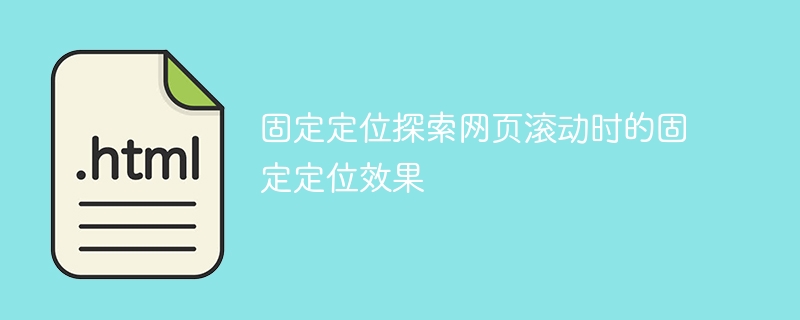

Fixed positioning explores the fixed positioning effect when scrolling the webpage
With the development of Internet technology, web design pays more and more attention to user experience. Among them, fixed positioning effect is a common and practical design technique. With fixed positioning, an element is fixed at a specific location on the page so that it remains stationary no matter how the page is scrolled. This effect provides a better interactive experience, making it easier for users to access key information on the website. This article will explore how to achieve fixed positioning effects when scrolling web pages and provide specific code examples.
1. CSS to achieve fixed positioning
To achieve fixed positioning effect, we can use the position attribute in CSS. The position attribute has multiple values, one of which is fixed. When the position attribute of an element is set to fixed, the element will be positioned relative to the visible area of the browser window and will not change position as the page scrolls.
For example, if we want to implement a navigation bar fixed at the top of the page, we can achieve it through the following CSS code:
.navbar {
position: fixed;
top: 0;
width: 100%;
background-color: #ffffff;
}In the above example, we first selected the navigation bar with the .navbar class element, and then set its position property to fixed so that the navigation bar is fixed at the top of the page (top: 0). At the same time, we also set its width to 100% and its background color to white to distinguish it from the rest of the page.
Using the position attribute in CSS can easily achieve fixed positioning effects without other complicated operations. However, it should be noted that when an element uses fixed positioning, it breaks away from the normal document flow and may affect the layout of other elements.
2. JS to achieve fixed positioning
In addition to using CSS, we can also use JavaScript to achieve fixed positioning effects. By listening to the page scroll event and changing the position attribute of the element, a fixed positioning effect is achieved.
The following is an example of using native JavaScript to implement fixed positioning:
window.addEventListener('scroll', function() {
var navbar = document.getElementById('navbar');
var scrollTop = window.pageYOffset || document.documentElement.scrollTop;
if (scrollTop > 200) {
navbar.style.position = 'fixed';
navbar.style.top = '0';
} else {
navbar.style.position = 'static';
}
});In the above example, we first obtain the element with the id navbar, and then obtain the page in real time by listening to the scroll event The scrolling distance of scrollTop. When the scroll distance is greater than 200, we set the position property of the navigation bar to fixed and the top property to 0, so that it is fixed at the top of the page. On the other hand, if the scroll distance is less than or equal to 200, we set the position property to static to restore it to the normal document flow.
3. Comprehensive application
Fixed positioning is often used in actual web design. The following is a comprehensive application example that implements a return to top button fixed in the lower right corner of the page:
HTML code:
<button id="btn-top" class="btn-top">返回顶部</button>
CSS code:
.btn-top {
position: fixed;
bottom: 20px;
right: 20px;
padding: 10px 20px;
background-color: #eeeeee;
border: none;
display: none;
}
.btn-top.show {
display: block;
}JavaScript code:
window.addEventListener('scroll', function() {
var btnTop = document.getElementById('btn-top');
var scrollTop = window.pageYOffset || document.documentElement.scrollTop;
if (scrollTop > 800) {
btnTop.classList.add('show');
} else {
btnTop.classList.remove('show');
}
});
document.getElementById('btn-top').addEventListener('click', function() {
window.scrollTo({
top: 0,
behavior: 'smooth'
});
});In the above example, we determine the page scrolling distance by listening to the scroll event, When the scroll distance is greater than 800, set the class of the return to top button to show to display the button. At the same time, we also added a click event listener for the button. When the button is clicked, the scrollTo method is used to scroll the page to the top, so that the user can easily return to the top of the page.
The above is the specific implementation method of fixed positioning to explore the fixed positioning effect when scrolling the web page. By using CSS or JavaScript, we can easily achieve various fixed positioning effects, improve user experience, and make web pages more beautiful and convenient.
The above is the detailed content of Explore the fixed positioning effect during web page scrolling. For more information, please follow other related articles on the PHP Chinese website!
 The difference between Fahrenheit and Celsius
The difference between Fahrenheit and Celsius
 The role of float() function in python
The role of float() function in python
 Configure Java runtime environment
Configure Java runtime environment
 What to do if the documents folder pops up when the computer is turned on
What to do if the documents folder pops up when the computer is turned on
 The role of registering a cloud server
The role of registering a cloud server
 How to buy Ripple in China
How to buy Ripple in China
 NTSD command usage
NTSD command usage
 phpstudy database cannot start solution
phpstudy database cannot start solution
 Usage of background-image
Usage of background-image




